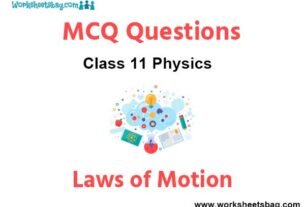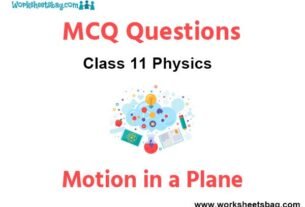Please refer to Motion in a Straight Line MCQ Questions Class 11 Physics below. These MCQ questions for Class 11 Physics with answers have been designed as per the latest NCERT, CBSE books, and syllabus issued for the current academic year. These objective questions for Motion in a Straight Line will help you to prepare for the exams and get more marks.
Motion in a Straight Line MCQ Questions Class 11 Physics
Please see solved MCQ Questions for Motion in a Straight Line in Class 11 Physics. All questions and answers have been prepared by expert faculty of standard 11 based on the latest examination guidelines.
MCQ Questions Class 11 Physics Motion in a Straight Line
Question. A particle travels half the distance with a velocity of 6 ms-1 . The remaining half distance is covered with a velocity of 4 ms-1 for half the time and with a velocity of 8 ms-1 for the rest of the half time. What is the velocity of the particle averaged over the whole time of motion ?
(a) 9 ms–1
(b) 6 ms–1
(c) 5.35 ms–1
(d) 5 ms–1
Answer
B
Question. A food packet is released from a helicopter rising steadily at the speed of 2 m/sec. After 2 seconds the velocity of the packet is (g = 10 m/sec2)
(a) 22 m/sec
(b) 20 m/sec
(c) 18 m/sec
(d) none of these
Answer
C
Question. The displacement x of a particle at the instant when its velocity is v is given by v = √3x + 16 Its acceleration and initial velocity are
(a) 1.5 units, 4 units
(b) 3 units, 4 units
(b) 16 units, 1.6 units
(d) 16 units, 3 units
Answer
A
Question. A rubber ball is dropped from a height of 5 metre on a plane where the acceleration due to gravity is same as that onto the surface of the earth. On bouncing, it rises to a height of 1.8 m. On bouncing, the ball loses its velocity by a factor of
(a) 3/5
(b) 9/25
(c) 2/5
(d) 16/25
Answer
C
Question. A boy moving with a velocity of 20 km h–1 along a straight line joining two stationary objects. According to him both objects
(a) move in the same direction with the same speed of 20 km h–1
(b) move in different direction with the same speed of 20 km h–1
(c) move towards him
(d) remain stationary
Answer
A
Question. An electron starting from rest has a velocity that increases linearly with time i.e. v = kt where k = 2 ms-2 . The distance covered in the first 3 second is
(a) 9 m
(b) 16 m
(c) 27 m
(d) 36 m
Answer
A
Question. The distance time graph of a particle at time t makes angles 45° with the time axis. After one second, it makes angle 60° with the time axis. What is the acceleration of the particle?
(a) √3-1
(b) √3+1
(c) √3
(d) 1
Answer
C
Question. A man leaves his house for a cycle ride. He comes back to his house after half-an-hour after covering a distance of one km. What is his average velocity for the ride ?
(a) zero
(b) 2 km h–1
(c) 10 km s–1
(d) 1/2 km s-1
Answer
A
Question. Two particles A and B are connected by a rigid rod AB. The rod slides along perpendicular rails as shown here. The velocity of A to the left is 10 m/s. What is the velocity of B when angle a = 60°?

(a) 9.8 m/s
(b) 10 m/s
(c) 5.8 m/s
(d) 17.3 m/s
Answer
C
Question. A body released from the top of a tower falls through half the height of the tower in 2 s. In what time shall the body fall through the height of the tower ?
(a) 4 s
(b) 3.26 s
(c) 3.48 s
(d) 2.828 s
Answer
D
Question. A ball released from a height falls 5 m in one second. In 4 seconds it falls through
(a) 20 m
(b) 1.25 m
(c) 40 m
(d) 80 m
Answer
D
Question. Let A, B, C, D be points on a vertical line such that AB = BC = CD. If a body is released from position A, the times of descent through AB, BC and CD are in the ratio.
(a) 1: √3 – √2 : √3 + √2
(b) 1: √2 -1: √3 – √2
(c) 1: √2 -1: √3
(d) 1: v2 : √3 -1
Answer
B
Question. Figure shows the position of a particle moving along the X-axis as a function of time

Which of the following is correct?
(a) The particle has come to the rest 6 times
(b) The maximum speed is at t = 6 s.
(c) The velocity remains positive for t = 0 to t = 6 s.
(d) The average velocity for the total period shown is negative.
Answer
A
Question. When two bodies move uniformly towards each other, the distance decreases by 6 ms–1. If both bodies move in the same directions with the same speeds (as above), the distance between them increases by 4 ms–1. Then the speeds of the two bodies are
(a) 3 ms–1 and 3 ms–1
(b) 4 ms–1 and 2 ms–1
(c) 5 ms–1 and 1 ms–1
(d) 7 ms–1 and 3 ms–1
Answer
C
Question. A particle starting from rest falls from a certain height. Assuming that the acceleration due to gravity remain the same throughout the motion, its displacements in three successive half second intervals are S1, S2 and S3 then
(a) S1 : S2 : S3 = 1 : 5 : 9
(b) S1 : S2 : S3 = 1 : 3 : 5
(c) S1 : S2 : S3 = 9 : 2 : 3
(d) S1 : S2 : S3 = 1 : 1 : 1
Answer
B
Question. A particle has initial velocity (2i– + 3 j–) and acceleration (0.3i– + 0.2 j–) The magnitude of velocity after 10 seconds will be
(a) 9√2 units
(b) 5√2 units
(c) 5 units
(d) 9 units
Answer
B
Question. The relation between time t and distance x is t = ax2 +βx where a and b are constants. The retardation is
(a) 2av3
(b) 2βv3
(c) 2aβv3
(d) 2b2v3
Answer
A
Question. Preeti reached the metro station and found that the escalator was not working. She walked up the stationary escalator in time t1. On other days, if she remains stationary on the moving escalator, then the escalator takes her up in time t2. The time taken by her to walk up on the moving escalator
will be:

Answer
B
Question. A stone is just released from the window of a train moving along a horizontal straight track. The stone will hit the ground following a
(a) straight line path
(b) circular path
(c) parabolic path
(d) hyperbolic path
Answer
C
Question. A car accelerates from rest at a constant rate a for some time after which it decelerates at a constant rate β to come to rest. If the total time elapsed is t, the maximum velocity acquired by the car is given by

Answer
D
Question. A car moving with a speed of 40 km/hour can be stopped by applying brakes after at least 2m. If the same car is moving with a speed of 80km/hour, what is the minimum stopping distance.
(a) 8 m
(b) 6 m
(c) 4 m
(d) 2 m
Answer
A
Question. A man throws balls with same speed vertically upwards one after the other at an interval of 2 sec. What should be the speed of throw so that more than two balls are in air at any time
(a) only with speed 19.6 m/s
(b) more than 19.6 m/s
(c) at least 9.8 m/s
(d) any speed less then 19.6 m/s.
Answer
B
Question. A parachutist after bailing out falls 50 m without friction. When parachute opens, it decelerates at 2 m/s2 . He reaches the ground with a speed of 3 m/s. At what height, did he bail out ?
(a) 182 m
(b) 91 m
(c) 111 m
(d) 293 m
Answer
D
Question. A ball is dropped from a high rise platform at t = 0 starting from rest. After 6 seconds another ball is thrown downwards from the same platform with a speed v. The two balls meet at t = 18s. What is the value of v? (take g = 10 m/s2)
(a) 75 m/s
(b) 55 m/s
(c) 40 m/s
(d) 60 m/s
Answer
A
Question. A stone falls freely under gravity. It covers distances h1, h2 and h3 in the first 5 seconds, the next 5 seconds and the next 5 seconds respectively. The relation between h1, h2 and h3 is

Answer
A
Question. A train A which is 120 m long is running with velocity 20 m/s while train B which is 130 m long is running in opposite direction with velocity 30 m/s. What is the time taken by train B to cross the train A ?
(a) 5 sec
(b) 25 sec
(c) 10 sec
(d) 100 sec
Answer
A
Question. A train is moving towards east and a car is along north, both with same speed. The observed direction of car to the passenger in the train is
(a) east-north direction
(b) west-north direction
(c) south-east direction
(d) None of the above
Answer
B
Question. A metro train starts from rest and in 5 s achieves 108 km/h. After that it moves with constant velocity and comes to rest after travelling 45 m with uniform retardation. If total distance travelled is 395 m, find total time of travelling.
(a) 12.2 s
(b) 15.3 s
(c) 9 s
(d) 17.2 s
Answer
D
Question. A particle moves along a straight line OX. At a time t (in second) the distance x (in metre) of the particle from O is given by x = 40 + 12t – t3. How long would the particle travel before coming to rest?
(a) 24 m
(b) 40 m
(c) 56 m
(d) 16 m
Answer
C
Question. Which one of the following equation represents the motion of a body moving with constant finite acceleration? In these equation, y denotes the displacement in time t and p, q and r are constant:
(a) y = (p + qt )(t + pt)
(b) y = p + t/r
(c) y = (p + t) (q + t ) (r + t)
(d) y = (p + qt/rt)
Answer
A
Question. A ball is thrown up with velocity 19.6 m/s. The maximum height attained by the ball is
(a) 29.2 m
(b) 9.8 m
(c) 19.6 m
(d) 15.8 m
Answer
C
Question. A ball is released from the top of a tower of height h meters. It takes T seconds to reach the ground. What is the position of the ball at T/3 second
(a) 8h/9 meters from the ground
(b) 7h/9 meters from the ground
(c) h/9 meters from the ground
(d) 17h/18 meters from the ground
Answer
A
Question. The motion of particle is described by the equation x = a + bt2, where a = 15 cm and b = 3 cm/sec2. Its instant velocity at time 3 sec will be
(a) 36 cm/sec
(b) 9 cm/sec
(c) 4.5 cm/sec
(d) 18 cm/sec
Answer
D
Question. The displacement of particle is given by

Answer
B
Question. A boat takes 2 hours to travel 8 km and back in still water lake. With water velocity of 4 km h–1, the time taken for going upstream of 8 km and coming back is
(a) 160 minutes
(b) 80 minutes
(c) 100 minutes
(d) 120 minutes
Answer
A
Question. A lift in which a man is standing, is moving upwards with a speed of 10 ms–1. The man drops a coin from a height of 4.9 metre and if g = 9.8 ms–2, then the coin reaches the floor of the lift after a time
(a) √2s
(b) 1s
(c) 1/2
(d) 1/√2
Answer
B
Question. Figure here gives the speed-time graph for a body. The displacement travelled between t = 1.0 second and t = 7.0 second is nearest to

(a) 1.5 m
(b) 2 m
(c) 3 m
(d) 4 m
Answer
B
Question. The water drops fall at regular intervals from a tap 5 m above the ground. The third drop is leaving the tap at an instant when the first drop touches the ground. How far above the ground is the second drop at that instant ?
(Take g = 10 m/s2)
(a) 1.25 m
(b) 2.50 m
(c) 3.75 m
(d) 5.00 m
Answer
C
Question. The displacement time graph of a moving particle is shown below

The instantaneous velocity of the particle is negative at the point
(a) D
(b) F
(c) C
(d) E
Answer
D
Question. Which of the following curve does not represent motion in one dimension?

Answer
B
Question. Among the four graph shown in the figure there is only one graph for which average velocity over the time interval (O, T) can vanish for a suitably chosen T. Which one is it?

Answer
B
Question. A particle moves along a straight line such that its displacement at any time t is given by s = (t3 – 6t2 + 3t + 4) metres The velocity when the acceleration is zero is
(a) 3 ms–1
(b) – 12 ms –1
(c) 42 ms–2
(d) – 9 ms–1
Answer
D
Question. A body starts from rest, what is the ratio of the distance travelled by the body during the 4th and 3rd seconds ?(a) 7/5
(b) 5/7
(c) 7/3
(d) 3/7
Answer
A
Question. In one dimensional motion, instantaneous speed v satisfies 0 £ v < v0.
(a) The displacement in time T must always take nonnegative values
(b) The displacement x in time T satisfies –v0T < x < v0T
(c) The acceleration is always a non-negative number
(d) The motion has no turning points
Answer
B
Question. A stone falls freely under gravity. It covers distances h1, h2 and h3 in the first 5 seconds, the next 5 seconds and the next 5 seconds respectively. The relation between h1, h2 and h3 is
(a) h1 = (h2/3) = (h3/5)
(b) h2 = 3h1 and h3 = 3h2
(c) h1 = h2 = h3
(d) h1 = 2h2 = 3h3
Answer
A
Question. A car travels from A to B at a speed of 20 km h–1 and returns at a speed of 30 km h–1. The average speed of the car for the whole journey is
(a) 5 km h–1
(b) 24 km h–1
(c) 25 km h–1
(d) 50 km h–1
Answer
B
Question. A vehicle travels half the distance l with speed v1 and the other half with speed v2, then its average speed is

Answer
C
Question. A body dropped from a height ‘h’ with an initial speed zero, strikes the ground with a velocity 3 km/hour. Another body of same mass dropped from the same height ‘h’ with an initial speed u’ = 4 km/hour. Find the final velocity of second mass, with which it strikes the ground
(a) 3 km/hr
(b) 4 km/hr
(c) 5 km/hr
(d) 6 km/hr
Answer
C
Question. If the velocity of a particle is v = At + Bt2, where A and B are constants, then the distance travelled by it between 1s and 2s is :

Answer
C



